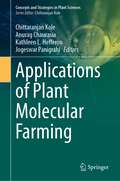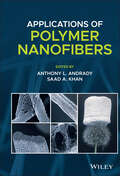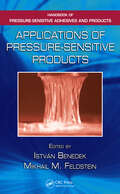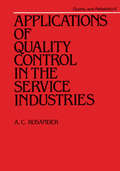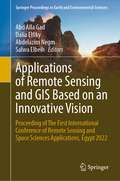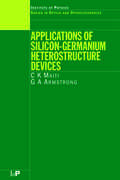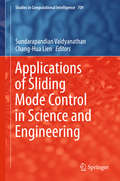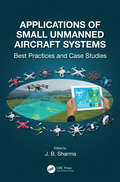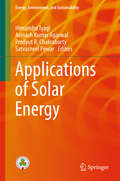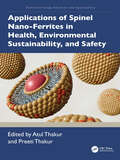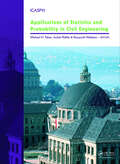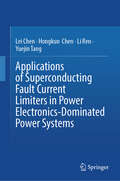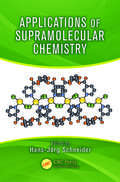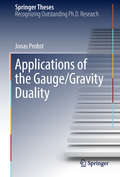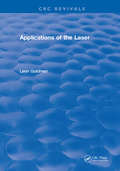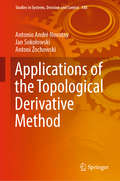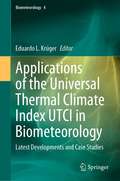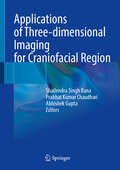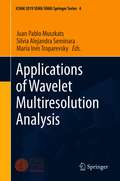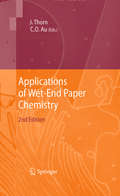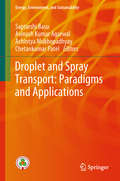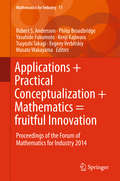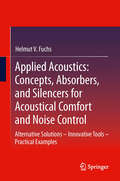- Table View
- List View
Applications of Photovoltaics
by R HillPhotovoltaics (PV) play a vital role in an energy-conscious society where the demand for cheap, convenient, and environmentally benign sources of energy is certain to increase. The range of applications is immense, encompassing many spheres of activity, from modern consumer electronics to the supply of power. Bringing together experts in their fields, Applications of Photovoltaics provides a stimulating account of the technical and economic aspects of the many areas that PV technology has been or is soon to be implemented. The book includes chapters on terrestrial applications of PV; PV for development, placing PV in the context of an energy policy for developing countries; PV for developing countries, which discusses the techno-economics of PV applications; PV systems for professional applications, which include hybrid systems; and low-power applications of PV for consumer, leisure, and other systems. Applications of Photovoltaics is appealing to all engineers, from energy advisors and policy makers, with an interest in or need for off-grid electrical supplies, from microwatts to megawatts. Its level of presentation makes it accessible to those without an engineering or economics background.
Applications of Plant Molecular Farming (Concepts and Strategies in Plant Sciences)
by Chittaranjan Kole Anurag Chaurasia Kathleen L. Hefferon Jogeswar PanigrahiThis edited book is a comprehensive compilation of applications of plant molecular farming in various fields including agriculture, industry and medicine, using different plant/crop systems as bioreactors for the bulk production of products of interest. The book places special emphasis on plant molecular farming being utilized for the bulk production of biologics, industrial enzymes, vaccines, drugs and recombinant pharmaceutical proteins.Plant molecular farming (PMF) is an upcoming promising interdisciplinary subject, and therefore the book contains contributions from experts across the disciplines. The utilization of plant viral vectors to produce biologics, virus-like particles and antimicrobial peptides via PMF have been highlighted. Molecular farming for the bulk production of recombinant pharmaceutical proteins and various types of human and veterinary vaccines in different crops/plants and genetically modified seeds has been included. The process of scaling up to manufacturing capacity, product formation by bioprocessing of plant cell suspension culture, and bioreactor engineering have been incorporated. Lastly, the book provides special coverage on utilizing PMF made products to control neglected tropical diseases and plant-made antigens as immunotherapies for allergic and autoimmune diseases.The book has chapters from leading experts on the subject, making it equally beneficial for researchers, policy planners, industrialists, medical professionals, entrepreneurs, and students of various related disciplines.
Applications of Polymer Nanofibers
by Anthony L. Andrady Saad A. KhanAPPLICATIONS OF POLYMER NANOFIBERS Explore a comprehensive review of the practical experimental and technological details of polymer nanofibers with a leading new resource Applications of Polymer Nanofibers delivers a complete introduction to the basic science of polymer nanofibers as well as a review of their diverse applications. The book assesses their potential for commercialization and presents contributions from leading experts emphasizing their practical and technological details. New and up to date research findings are presented throughout the book in areas including filters, fabric, energy, fuel cells, batteries, sensors, biomedicine, drug delivery, tissue engineering, and wound dressings. The book also presents a fulsome analysis of the technology of electrospinning, the most convenient and scalable technique for nanofiber production. It also provides readers with practical information on relevant surface modification techniques. Applications of Polymer Nanofibers effectively balances theoretical background with practical applications of the technology, including insights into polymer nanofiber materials that will be useful for advanced students and researchers. Students, researchers, and industry professionals will also enjoy the inclusion of: A thorough introduction to electrospinning parameters and resulting nanofiber characteristics, including theoretical and practical considerations An exploration of textile applications of nanofibers, like protective clothing, filter fabrics, wearable devices, functional fabrics, and biomedical textiles A review of nanofiber mats as high-efficiency filters, including filtration developments, filters made with nanofibers, and the future outlook for nanofiber filters A treatment of nanofiber-based chemical sensors, including sensor materials, approaches to nanofiber sensor design, and gravimetric nanofiber sensors Perfect for researchers and graduate students studying polymer science and engineering, chemical engineering, materials science, and nanotechnology. Applications of Polymer Nanofibers will also earn a place in the libraries of industrial researchers concerned with electrospinning, air filtration, fabrics, drug delivery, catalysis, and biomedicine.
Applications of Pressure-Sensitive Products (Handbook of Pressure-Sensitive Adhesives and Products)
by IstvÁn Benedek Mikhail M. FeldsteinPresenting the end-use and application technologies of pressure-sensitive adhesives and products, Volume Three of the Handbook of Pressure-Sensitive Adhesives and Products discusses the build up and classes
Applications of Quality Control in the Service Industries (Quality and Reliability)
by A. C. RosanderThis book discusses basic concepts, principles, and quality characteristics in the service industries, an understanding of the techniques and their applications. It helps to close the gap between proven principles and successful applications.
Applications of Remote Sensing and GIS Based on an Innovative Vision: Proceeding of The First International Conference of Remote Sensing and Space Sciences Applications, Egypt 2022 (Springer Proceedings in Earth and Environmental Sciences)
by Abd Alla Gad Dalia Elfiky Abdelazim Negm Salwa ElbeihThis book covers various aspects of remote sensing and geographic information systems, from the perspective of earth and environmental sciences. The theme of applications of remote sensing and geographic information systems for the purposes of sustainable development highlights the innovative usage of space imaged spectral data in soil characterization. This book merges the selected contributions to the First International Conference of Remote Sensing and Space Sciences Applications (Egypt 2022) aiming to promote the latest findings on the development of Space Technologies and Applications.
Applications of Robotics in Industry Using Advanced Mechanisms: Proceedings of International Conference on Robotics and Its Industrial Applications 2019 (Learning and Analytics in Intelligent Systems #5)
by Janmenjoy Nayak Valentina E. Balas Margarita N. Favorskaya Bibhuti Bhusan Choudhury S. Krishna Mohan Rao Bighnaraj NaikThis book shares important findings on the application of robotics in industry using advanced mechanisms, including software and hardware. It presents a collection of recent trends and research on various advanced computing paradigms such as soft computing, robotics, smart automation, power control, and uncertainty analysis. The book constitutes the proceedings of the 1st International Conference on Application of Robotics in Industry using Advanced Mechanisms (ARIAM2019), which offered a platform for sharing original research findings, presenting innovative ideas and applications, and comparing notes on various aspects of robotics. The contributions highlight the latest research and industrial applications of robotics, and discuss approaches to improving the smooth functioning of industries. Moreover, they focus on designing solutions for complex engineering problems and designing system components or processes to meet specific needs, with due considerations for public health and safety, including cultural, societal, and environmental considerations. Taken together, they offer a valuable resource for researchers, scientists, engineers, professionals and students alike.
Applications of Silicon-Germanium Heterostructure Devices (Series in Optics and Optoelectronics)
by C.K Maiti G.A ArmstrongThe first book to deal with the design and optimization of transistors made from strained layers, Applications of Silicon-Germanium Heterostructure Devices combines three distinct topics-technology, device design and simulation, and applications-in a comprehensive way. Important aspects of the book include key technology issues for the growth of st
Applications of Sliding Mode Control in Science and Engineering (Studies in Computational Intelligence #709)
by Sundarapandian Vaidyanathan Chang-Hua LienGathering 20 chapters contributed by respected experts, this book reports on the latest advances in and applications of sliding mode control in science and engineering. The respective chapters address applications of sliding mode control in the broad areas of chaos theory, robotics, electrical engineering, physics, chemical engineering, memristors, mechanical engineering, environmental engineering, finance, and biology. Special emphasis has been given to papers that offer practical solutions, and which examine design and modeling involving new types of sliding mode control such as higher order sliding mode control, terminal sliding mode control, super-twisting sliding mode control, and integral sliding mode control. This book serves as a unique reference guide to sliding mode control and its recent applications for graduate students and researchers with a basic knowledge of electrical and control systems engineering.
Applications of Small Unmanned Aircraft Systems: Best Practices and Case Studies
by J. B. SharmaAdvances in high spatial resolution mapping capabilities and the new rules established by the Federal Aviation Administration in the United States for the operation of Small Unmanned Aircraft Systems (sUAS) have provided new opportunities to acquire aerial data at a lower cost and more safely versus other methods. A similar opening of the skies for sUAS applications is being allowed in countries across the world. Also, sUAS can access hazardous or inaccessible areas during disaster events and provide rapid response when needed. Applications of Small Unmanned Aircraft systems: Best Practices and Case Studies is the first book that brings together the best practices of sUAS applied to a broad range of issues in high spatial resolution mapping projects. Very few sUAS pilots have the knowledge of how the collected imagery is processed into value added mapping products that have commercial and/or academic import. Since the field of sUAS applications is just a few years old, this book covers the need for a compendium of case studies to guide the planning, data collection, and most importantly data processing and map error issues, with the range of sensors available to the user community. Written by experienced academics and professionals, this book serves as a guide on how to formulate sUAS based projects, from choice of a sUAS, flight planning for a particular application, sensors and data acquisition, data processing software, mapping software and use of the high spatial resolution maps produced for particular types of geospatial modeling. Features: Focus on sUAS based data acquisition and processing into map products Broad range of case studies by highly experienced academics Practical guidance on sUAS hardware, sensors, and software utilized Compilation of workflow insights from expert professors and professionals Relevant to academia, government, and industry Positional and thematic map accuracy, UAS curriculum development and workflow replicability issues This book would be an excellent text for upper-level undergraduate to graduate level sUAS mapping application courses. It is also invaluable as a reference for educators designing sUAS based curriculum as well as for potential sUAS users to assess the scope of mapping projects that can be done with this technology.
Applications of Solar Energy (Energy, Environment, and Sustainability)
by Avinash Kumar Agarwal Himanshu Tyagi Prodyut R. Chakraborty Satvasheel PowarThis book focuses on solar-energy-based renewable energy systems and discusses the generation of electric power using solar photovoltaics, as well as some new techniques, such as solar towers, for both residential and commercial needs. Such systems have played an important role in the move towards low-emission and sustainable energy sources. The book covers a variety of applications, such as solar water heaters, solar air heaters, solar drying, nanoparticle-based direct absorption solar systems, solar volumetric receivers, solar-based cooling systems, solar-based food processing and cooking, efficient buildings using solar energy, and energy storage for solar thermal systems. Given its breadth of coverage, the book offers a valuable resource for researchers, students, and professionals alike.
Applications of Spinel Nano-Ferrites in Health, Environmental Sustainability, and Safety (Nanotechnology Advances and Applications)
by Atul Thakur Preeti ThakurThis book presents the foundational concepts of spinel nano-ferrites, their synthesis techniques, and their cutting-edge applications in various fields. The book begins with an introduction to spinel nano-ferrites, discussing their unique properties and historical context. It then delves into various synthesis techniques, such as sol-gel methods, co-precipitation, and hydrothermal processes, highlighting the influence of these methods on the resultant structures and morphologies. The book also reviews the electrical and magnetic characteristics of spinel nano-ferrites, demonstrating their potential in electronic and magnetic devices. The role of spinel nano-ferrites in the health sector is explored in depth, detailing their use as antibacterial and antifungal agents and their innovative applications in magnetic resonance imaging (MRI), cancer detection, targeted drug delivery, and hyperthermia treatment. The chapters further examine the environmental applications of spinel nano-ferrites, including their effectiveness in pollution remediation, water purification, dye degradation, and the detection and removal of heavy metal ions and microplastics from wastewater. Toward the end, the book explores the development of gas sensors and humidity sensors using spinel nano-ferrites, as well as devices designed for human and environmental safety. This book is intended for researchers and students of nanotechnology, nanobiotechnology, healthcare professionals, and environmental scientists.Key Features: Covers foundational concepts, unique properties, and cutting-edge applications of spinel nano-ferrites Explores various synthesis methods such as sol-gel, co-precipitation, and hydrothermal processes, and their impact on structures and morphologies of spinel nano-ferrites Discusses the electrical and magnetic characteristics of spinel nano-ferrites Examines the potential of spinel nano-ferrites as antibacterial and antifungal agents, and their roles in MRI, cancer detection, and drug delivery Highlights the effectiveness of spinel nano-ferrites in pollution remediation, water purification, and dye degradation
Applications of Statistics and Probability in Civil Engineering
by M. H. Faber J. Köhler K. NishijimaUnder the pressure of harsh environmental conditions and natural hazards, large parts of the world population are struggling to maintain their livelihoods. Population growth, increasing land utilization and shrinking natural resources have led to an increasing demand of improved efficiency of existing technologies and the development of new ones. A
Applications of Superconducting Fault Current Limiters in Power Electronics-Dominated Power Systems
by Lei Chen Hongkun Chen Li Ren Yuejin TangThe book discusses superconducting fault current limiters and their applications in power systems, exploring the principles, simulations and engineering practices, but focusing on systematic applications in traditional and renewable power systems. It provides in-depth studies on a number of major topics such as architecture of superconducting fault current limiter, device design, parameter optimization, prototype testing, co-ordination control and performance evaluation. It also describes multiple application cases of superconducting fault current limiters, which are applied in high voltage direct current transmission systems, active distribution networks, and micro-grids. Offering a comprehensive and systematic overview of practical issues, the book is intended for readers wanting to learn practical approaches for developing superconducting fault current limiters. It also appeals to researchers, engineers and graduate students in various fields, including high-temperature superconducting materials, power system transient stability, and control science and engineering.
Applications of Supramolecular Chemistry
by Hans-Jörg SchneiderApplications of Supramolecular Chemistry introduces the use of non-covalent interactions and molecular recognition for many fields. Applications include the analysis of technically, medically, and environmentally important chemical compounds, their separation, purification and removal, and the design of new materials, including supramolecular elect
Applications of the Gauge/Gravity Duality (Springer Theses)
by Jonas ProbstMany open questions in Theoretical Physics pertain to strongly interacting quantum systems such as the quark-gluon plasma (QGP) produced in heavy-ion collisions or the strange-metal phase observed in many high-temperature superconductors. These systems are notoriously difficult to study using traditional methods such as perturbation theory, but the gauge/gravity duality offers a successful alternative approach, which maps strongly interacting quantum gauge theories to computationally tractable, classical gravity theories. This book begins with a pedagogical introduction to how the duality can be used to extract transport properties of quantum systems from their gravity dual. It then presents new results on hydrodynamic transport in strongly interacting quantum fluids, providing strong evidence that the Haack-Yarom identity between second-order transport coefficients holds for all fluids with a classical gravity dual and may be a universal feature of all strongly coupled quantum fluids such as the QGP. Newly derived Kubo formulae, expressing transport coefficients in terms of quantum correlators, hold independently of the duality. Lastly, the book discusses new results on magnetic impurities in strongly correlated metals, including the first dual gravity description of an inter-impurity coupling, crucial for the quantum criticality underlying the strange-metal phase.
Applications of the Laser: The Introduction Of Laser Applications Into Biology And Medicine
by Leon GoldmanThe laser's range of application is extraordinary. Arthur Schawlow says, "What instrument can shuck a bucket of oysters, correct typing errors, fuse atoms, lay a straight line for a garden bed, repair detached retinas, and drill holes in dia monds?"O The laser's specifically biomedical uses cover a similarly broad and interesting spectrum. In this book, I have endeavored to convey some of the fas cination that the laser has long held for me. It is my hope that both clinicians and researchers in the various medical and surgical specialties will find the book a use ful introduction. Biologists, particularly molecular biologists, should also find a great deal of relevant information herein. This volume's distinguished contributors provide admirably lucid discussions of laser principles, instrumentation, and current practice in their respective special ties. Safety, design, capabilities, and costs of various lasers are also reviewed. We have aimed to create a practical text that is comprehensive but not exhaustive. Our emphasis on the practical, rather than the esoteric, is dictated not only by the short history of biomedical laser use, but by the extent of the community to which this information will appeal.
Applications of the Topological Derivative Method (Studies in Systems, Decision and Control #188)
by Antonio André Novotny Jan Sokołowski Antoni ŻochowskiThe book presents new results and applications of the topological derivative method in control theory, topology optimization and inverse problems. It also introduces the theory in singularly perturbed geometrical domains using selected examples. Recognized as a robust numerical technique in engineering applications, such as topology optimization, inverse problems, imaging processing, multi-scale material design and mechanical modeling including damage and fracture evolution phenomena, the topological derivative method is based on the asymptotic approximations of solutions to elliptic boundary value problems combined with mathematical programming tools. The book presents the first order topology design algorithm and its applications in topology optimization, and introduces the second order Newton-type reconstruction algorithm based on higher order topological derivatives for solving inverse reconstruction problems. It is intended for researchers and students in applied mathematics and computational mechanics interested in the mathematical aspects of the topological derivative method as well as its applications in computational mechanics.
Applications of the Universal Thermal Climate Index UTCI in Biometeorology: Latest Developments and Case Studies (Biometeorology #4)
by Eduardo L. KrügerThis book introduces the UTCI (Universal Thermal Climate Index) and summarizes progress in this area. The UTCI was developed as part of the European COST Action Program and first announced to the scientific community in 2009. Since then, a decade has followed of applicability tests and research results, as well as knowledge gained from applying the UTCI in human adaptation and thermal perception. These findings are of interest to researchers in the interdisciplinary areas of biometeorology, climatology and urban planning. The book summarizes this progress, discussing the limitations found and provides pointers to future developments. It also discusses UTCI applications in the areas of human biometeorology and urban planning including possibilities of using UTCI and similar indices in climate-responsive urban planning. The book’s message is illustrated with many case studies from the real world.Chapter 10 is available open access under a Creative Commons Attribution 4.0 International License via link.springer.com.
Applications of Three-dimensional Imaging for Craniofacial Region
by Shailendra Singh Rana Prabhat Kumar Chaudhari Abhishek GuptaThe book provides sound knowledge of 3D imaging of dentofacial craniofacial region. It guides the students and faculty for understanding the dentofacial craniofacial region in depth. It incorporates the latest techniques, frameworks and technologies in the imaging area of oral health. The book emphasizes on the dentofacial and craniofacial region and thus fills the gap in the medical imaging literature. The development in this book is not only on the imaging techniques but also emphasis will be on the three-dimensional (3D) frameworks to deal the patients for their diagnosis and treatment planning. The chapters of this book are designed in such a way that the readers may get the complete package of the exploration of the imaging clinical applications of craniofacial areas. This book will be helpful not only for the students and faculty but also for the researchers working in the relevant areas.This book will provide easy, simple way but the most authentic material to learn the craniofacial region imaging. In this manual we will incorporates authentic, internationally accepted terms and definition. To make it interesting and simple, our approach is to incorporate the material in systematic manner in a simple and easy way by incorporating maximum illustrations and flowcharts. This book provides sound knowledge of various advanced technologies for dentist imaging. This book will highlights the importance and explore the current research in the dentofacial and craniofacial areas.
Applications of Wavelet Multiresolution Analysis (SEMA SIMAI Springer Series #4)
by Juan Pablo Muszkats Silvia Alejandra Seminara María Inés TroparevskyThis work results from a selection of the contributions presented in the mini symposium “Applications of Multiresolution Analysis with “Wavelets”, presented at the ICIAM 19, the International Congress on Industrial and Applied Mathematics held at Valencia, Spain, in July 2019. The presented developments and applications cover different areas, including filtering, signal analysis for damage detection, time series analysis, solutions to boundary value problems and fractional calculus. This bunch of examples highlights the importance of multiresolution analysis to face problems in several and varied disciplines. The book is addressed to researchers in the field.
Applications of Wet-End Paper Chemistry
by Ian Thorn Che On Au"Applications of Wet-end Paper Chemistry" bridges the gap between the theory and practice of wet-end paper chemistry by explaining how particular chemicals are chosen and put to use in real situations. A number of international experts in the field present recent contributions on the optimum use of chemicals in papermaking. Major inroads have taken place since the first edition of this title was published in 1995. This new edition of "Applications of Wet-end Paper Chemistry" will reflect the changing type and use of chemicals used in papermaking in the 21st century. Chemists and chemical engineers across the paper and pulp making industry, as well as in research and academic institutes will find this book of enormous practical value.
Applications Paradigms of Droplet and Spray Transport: Paradigms And Applications (Energy, Environment, and Sustainability)
by Avinash Kumar Agarwal Saptarshi Basu Achintya Mukhopadhyay Chetan PatelThis book focuses on droplets and sprays and their applications. It discusses how droplet level transport is central to a multitude of applications and how droplet level manipulation and control can enhance the efficiency and design of multiphase systems. Droplets and sprays are ubiquitous in a variety of multiphase and multiscale applications in surface patterning, oil recovery, combustion, atomization, spray drying, thermal barrier coating, renewable energy, and electronic cooling, to name but a few. This book provides two levels of details pertaining to such applications. Each chapter delves into a specific application and provides not only an overview but also detailed physical insights into the application mechanism from the point of view of droplets and sprays. All chapters provide a mix of cutting-edge applications, new diagnostic techniques and modern computational methodologies, as well as the fundamental physical mechanism involved in each application. Taken together, the chapters provide a translational perspective on these applications, from basic transport processes to optimization, and from design to implementation using droplets or sprays as fundamental building blocks. Given its breadth of coverage, the book will be of interest to students, researchers, and industry professionals alike.
Applications + Practical Conceptualization + Mathematics = fruitful Innovation: Proceedings of the Forum of Mathematics for Industry 2014 (Mathematics for Industry #11)
by Philip Broadbridge Yasuhide Fukumoto Tsuyoshi Takagi Robert S. Anderssen Kenji Kajiwara Evgeny Verbitskiy Masato WakayamaThis book is a collection of papers presented at the conference "Forum Math-for-Industry 2014" for which the unifying theme was "Applications + Practical Conceptualization + Mathematics = fruitful Innovation" in October 2014. This epigram encapsulates the dynamics of the process that takes an application through to an innovation. Industrial mathematics can be viewed as the causal engine that implements the epigram by taking an Application such as input and convolving it with a mixture of Practical Conceptualization and Mathematics to generate a fruitful Innovation as output. The book illustrates various aspects of the two-way interaction between applications and their association highlighting how practical conceptualization assists with the linking of the question that encapsulates the current application to the relevant mathematics. The contents of this volume address productive and successful interaction between industry and mathematicians, as well as the cross-fertilization and collaboration that result when mathematics is involved with the advancement of science and technology.
Applied Acoustics: Alternative Solutions - Innovative Tools - Practical Examples
by Helmut V. FuchsThe author gives a comprehensive overview of materials and components for noise control and acoustical comfort. Sound absorbers must meet acoustical and architectural requirements, which fibrous or porous material alone can meet. Basics and applications are demonstrated, with representative examples for spatial acoustics, free-field test facilities and canal linings. Acoustic engineers and construction professionals will find some new basic concepts and tools for developments in order to improve acoustical comfort. Interference absorbers, active resonators and micro-perforated absorbers of different materials and designs complete the list of applications.

